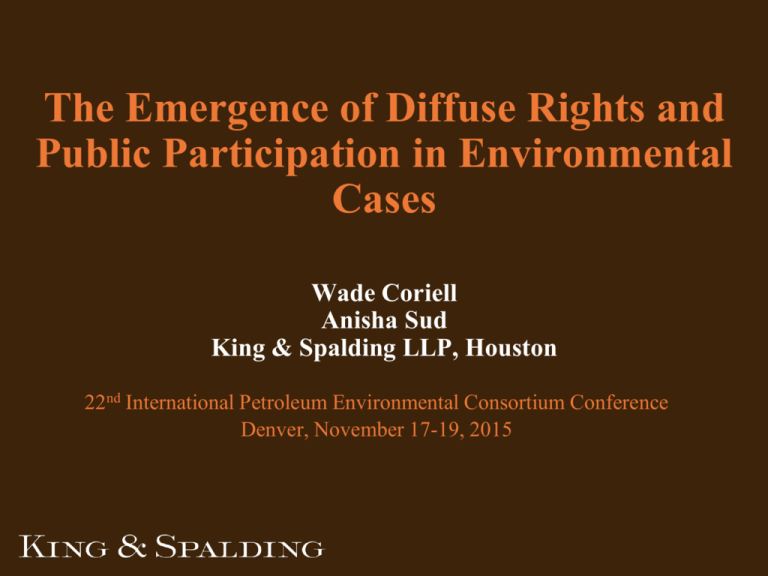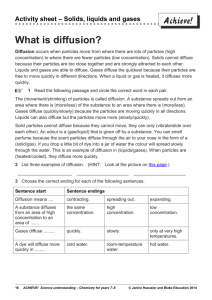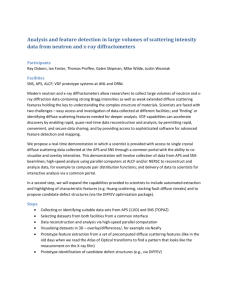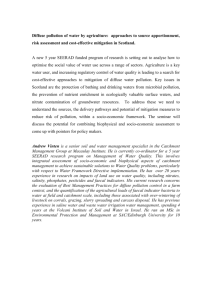The Emergence of Diffuse Rights and Public
advertisement

The Emergence of Diffuse Rights and Public Participation in Environmental Cases Wade Coriell Anisha Sud King & Spalding LLP, Houston 22nd International Petroleum Environmental Consortium Conference Denver, November 17-19, 2015 Society’s Autonomous Right to a Clean Environment In the last three decades, governments have increasingly recognized an independent societal right to a clean environment • For example, Article 225 of Brazil’s Constitution: • “All have the right to an environment that is ecologically in equilibrium and that is available for shared use by the people, essential to a healthy quality of life, which imposes on both the government and society as a whole the duty of protecting it and preserving it for both the present and future generations.” 2 Tort Law Insufficient to Protect This Autonomous Right • Tort law is the traditional mechanism for individuals and NGOs to remedy environmental harm: ― Primary objective is to compensate an injured individual, not to protect the environment ― Requires a showing of direct injury, causation, and established harm ― Premised on the vindication of individual rights for direct injuries 3 Emergence of Diffuse Rights Claims to Protect the Autonomous Environmental Right • • Diffuse Rights: ― Public, collective, indivisible, belong to the community ― Not subject to exclusive use or appropriation ― Damages not measured by individual harm; the benefiting class is indeterminate Ecuador’s 1999 Environmental Management Act defines diffuse interests as “homogenous and indivisible interests held by an indeterminate group of individuals tied by a common set of circumstances” and defines collective environmental rights as those “shared by the community to enjoy an environment that is healthy and free of contamination.” 4 Diffuse Rights ≠ Aggregated Individual Rights • • Aggregated Individual Rights: ― Class is determinate and identifiable, even if large (i.e., when a group of neighbors sue a contaminating factory for damage to their individual properties) ― Continue to allow for division or apportionment among individuals ― Right belongs to the individual and not the community Individual rights may be enforced individually or collectively through a representative, but diffuse rights must be enforced collectively through a representative and once vindicated, entire community is bound 5 Enforcement of Diffuse Rights – Civil Actions and Suits Judicial systems worldwide have begun to pass legislation that gives governments, individuals, and organizations the right to enforce diffuse environmental rights • These systems give resolved diffuse rights claims res judicata effect—after a final decision on the merits, the entire community is bound and the matter cannot be re-litigated • 6 Enforcement of Diffuse Rights – Civil Actions and Suits • For example, Article 82 of the Peruvian Civil Code: “Interests are diffuse when they are held by an indeterminate number of people and attach to goods of incalculable patrimonial value, such as the environment, as well as cultural, historical, and consumer goods or values. The Public Ministry, as well as nonprofit associations or institutions that have standing . . . may file or intervene in these actions.” “A final judgment upholding the complaint shall additionally bind [those] who have not participated in the proceedings.” 7 Enforcement of Diffuse Rights – Civil Actions and Suits • For example, Article 42 of Uruguay’s General Procedure Code: “The Public Ministry and any interested individual, in addition to public interest institutions or associations that . . . adequately represent the interests at stake, shall have standing in cases involving the defense of the environment, as well as cultural or historical values that are shared by an indeterminate group of people.” Article 220: “In suits filed in defense of diffuse rights (Art. 42), the judgment shall have general effect . . . .” 8 Enforcement of Diffuse Rights – Public Participation in Lawmaking Judicial systems have also encouraged public participation in government decisions affecting the environment as another means of enforcing diffuse rights • For example, Article 330 of Colombia’s Constitution requires the government to ensure indigenous communities’ participation in decisions that exploit natural resources on their lands • The efficacy of such provisions is unclear • 9 Can Diffuse Rights Claims Fill the Gap? • • Res judicata provisions must be enforced uniformly and consistently across legal systems for diffuse rights regimes to have legitimacy and credibility If not: ― Each member of an indeterminate class could recover again and again from the same defendant for the same acts, rights, and damages ― Risk of conflicting decisions on the same issues ― Defendants would have no incentive to settle; governments would lose a valuable tool for environmental remediation ― Waste of judicial resources and inefficient 10 Cautious Optimism • • • Res judicata effect has not been extensively tested in dispute resolution, but a few notable decisions: Chevron v. Ecuador arbitral tribunal found that a Settlement Agreement settled in full certain diffuse rights “[The Tribunal] rejects entirely the third possibility that the same diffuse right . . . can exist in separate parts, to be exercised by multiple claimants at different times with successive diffuse claims, thereby making any effective final settlement or adjudication of such claims illusory.” Satsky v. Paramount Commc’ns, Inc., Tenth Circuit found “. . . If the claims are for injuries to interests which all citizens hold in common, and for which the State has already recovered, the judgment . . . acts as a bar.” 11 Implications on the Petroleum Industry • • • International oil companies are inherently involved in the exploitation of natural resources; activities often occur near sensitive environmental receptors Diffuse rights claims are likely to become more common with the proliferation of diffuse rights regimes Provided res judicata effect is given to final adjudications of diffuse rights claims, IOCs can experience significant relief ― Assured their settlement is forever, even if a member of the community later objects ― But not protected against individual claims 12 References • • • • • • • • • • • • • • Mark Latham, Victor E. Schwartz, and Christopher E. Appel, The Intersection of Tort and Environmental Law: Where the Twains Should Meet and Depart, 80 FORDHAM L. REV. 737 (2011). Adam D.K. Abelkop, Tort Law as an Environmental Policy Instrument, 92 OREGON L. REV. 381 (2014). Arlindo Daibert, Diffuse Damages in Environmental Torts in Brazil, in ENVIRONMENTAL LAW AND SUSTAINABILITY AFTER RIO 196, 201 (Jamie Benidickson et. al. ed., 2011). Antonio de Aguiar Patriota, An Introduction to Brazilian Environmental Law, 40 GEO. WASH. INT’L L. REV. 611 (2009). Lesley K. McAllister, On Environmental Enforcement and Compliance: A Reply to Professor Crawford’s Review of Making Law Matter: Environmental Protection and Legal Institutions in Brazil, 40 GEO. WASH. INT’L L. REV. 649 (2009) American Law Institute, Principles of the Law of Aggregate Litigation (2010) § 1.02 Christopher Tanner et. al., Making rights a reality: Participation in practice and lessons learned in Mozambique, LSP Working Paper 27, Access to Natural Resources Sub-Programme, Food and Agriculture Organization of the United Nations (2006) Jorge Caillaux, Manuel Ruiz, and Isabel Lapeña, Environmental Public Participation in the Americas, in THE NEW “PUBLIC,” THE GLOBALIZATION OF PUBLIC PARTICIPATION 105 (Carl Bruch ed., 2002). 1988 Constitution of the Federative Republic of Brazil, art. 225 (2010 version). 1999 Environmental Management Act, Glossary (Ecuador). C. Civ. Pro. art. 82 (1993) (Peru). Gen. Pro. C., L. 15.982, art. 42 (1988) (Uru.). Chevron Corp. and Texaco Petroleum Co. v. Republic of Ecuador, PCA Case No. 2009-23, First Partial Award on Track I, Sept. 17, 2013, ¶ 107 (emphasis added). Satsky v. Paramount Commc’ns, Inc., 7 F.3d 1464 (10th Cir. 1993). 13





